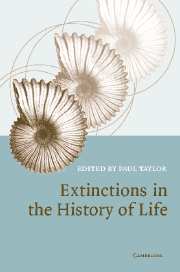Book contents
- Frontmatter
- Contents
- Notes on contributors
- Preface
- 1 Extinction and the fossil record
- 2 Extinctions in life's earliest history
- 3 Mass extinctions in plant evolution
- 4 The beginning of the Mesozoic: 70 million years of environmental stress and extinction
- 5 Causes of mass extinctions
- 6 The evolutionary role of mass extinctions: disaster, recovery and something in-between
- Glossary
- Index
- References
3 - Mass extinctions in plant evolution
Published online by Cambridge University Press: 18 December 2009
- Frontmatter
- Contents
- Notes on contributors
- Preface
- 1 Extinction and the fossil record
- 2 Extinctions in life's earliest history
- 3 Mass extinctions in plant evolution
- 4 The beginning of the Mesozoic: 70 million years of environmental stress and extinction
- 5 Causes of mass extinctions
- 6 The evolutionary role of mass extinctions: disaster, recovery and something in-between
- Glossary
- Index
- References
Summary
INTRODUCTION
Mass extinctions generally are recognized as major features in the history of life. They sweep aside diverse, sometimes even dominant groups of organisms, freeing up resources that can then fuel the diversification and rise to dominance of lineages that survived the mass extinction. This view of the history of life has been developed in large part from the study of shelly marine animals, and to a lesser extent from studies of terrestrial vertebrates (e.g. Valentine, 1985). By compiling data on the stratigraphic ranges of genera and families of marine animals, palaeontologists have been able to recognize the ‘Big Five’ mass extinctions, occurring at the end of the Ordovician, in the Late Devonian and at the end of the Permian, Triassic and Cretaceous periods (e.g. Sepkoski, 1993; Chapters 1 and 5). Each of these episodes is a geologically sudden decrease in taxonomic diversity. Terrestrial vertebrates also show major declines in taxonomic diversity at the end of the Permian and at the end of the Cretaceous (Benton, 1993). In contrast, compilations of the stratigraphic ranges of species of land plants do not show major declines in diversity (Niklas et al., 1980, 1985; Niklas and Tiffney, 1994; Figure 3.1). The absence of major declines in the diversity of land plants as represented in these compilations of stratigraphic ranges has led to the suggestion that plants are more resistant to mass extinctions than animals (Niklas et al., 1980; Knoll, 1984; Traverse, 1988).
- Type
- Chapter
- Information
- Extinctions in the History of Life , pp. 61 - 98Publisher: Cambridge University PressPrint publication year: 2004
References
- 23
- Cited by



